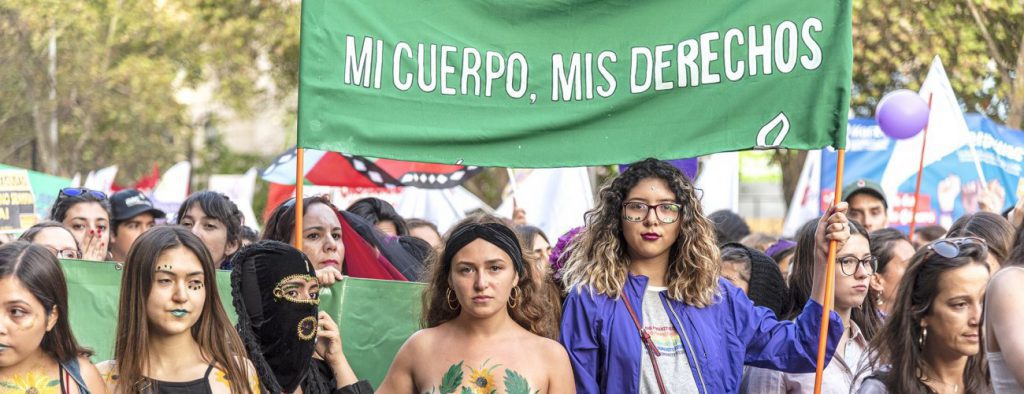Number 3 / March 11
Gender in the Constitutional Convention
viernes 11 marzo, 2022
BOLETÍN DEL MONITOR CONSTITUCIONAL

viernes 11 marzo, 2022


One of the most remarkable features of the Constitutional Convention (CC) has been its symmetrical composition on a gender basis, securing equal number of seats for men and women constitution-makers. Chile is the first global case of total gender parity in the composition of a democratically elected constituent body.
In this edition of the Bulletin, we discuss the role that gender parity has undertaken during the current constitutional process. We begin by examining the historical background of the constitutional reform that enshrined gender parity. Then, we review the function played by gender in the development of the CC during its provisional and current stages of work. Finally, we examine the most relevant bills set before the CC and those draft constitutional rules that have been passed by the CC in relation to gender.
Gender became an issue from the outset of the current constitutional process. The Agreement for Social Peace and a New Constitution —which was signed by a cross-bench majority of Chilean political parties on November 15th, 2019, setting in motion the current constituent process—considered using existing electoral rules which govern the election of the Chamber of Deputies for the election of members of the CC. This legislation mandates that neither male or female candidates may exceed the other gender by 60% regarding the presentation of candidates lists for Congressional seats. This gender quota refers only to nominations and not to the proportion of gender in the composition of Congress after the election is held.
In the design of the CC legislators departed from the previous rules, taking a further step towards gender equality. A constitutional amendment was passed mandating that every list of candidates had to be headed by a woman, alternating successively between men and women. Moreover, rather than limiting to an increasement of gender quotas regarding candidates’ selection, this amendment was aimed to ensure gender equality in the actual composition of the CC. In districts where an even number of seats were elected, they had to be evenly distributed between men and women (50% for each gender), whereas in districts with an odd number of seats, one sex could only outnumber the other sex by one.
Although this constitutional amendment spoke of «men,» «women,» and «sex,» during the legislative proceedings it was identified as the «gender constitutional amendment bill”.
From the installation of the CC “gender” gained prominence, exerting its influence over decisions. Thus, gender equality and gender parity became common organizational principles throughout which the CC designed its provisional task forces to draft its rules and procedures. The centrality that of this notion undertook during this provisional stage became enshrined in the CC’s rules and procedures, consolidating itself as a transversal axis (together with plurinationality, human rights, inclusion, decentralization and socio-ecological perspectives) which must inform the drafting of the new Constitution within the CC.
Thus, “gender” has fulfilled different purposes in the CC:
a. As a criterion for giving the floor.
b. As a guiding principle for the development of the CC’s work.
c. As an adjective used by the CC to characterize itself, and for qualifying other concepts (i.e. gender correction, gender diversity, gender perspective, gender parity, gender violence, gender equality and gender approach).
d. As an integration criterion. In each thematic committee one gender cannot surpass the other over than 60%. If this limit is breached, the respective committee’s composition must be corrected until the allowed proportion is reached. Likewise, each committee is led by a duo of coordinators on an equal gender basis. This criterion was also followed for the incorporation of seven adjunct vice-presidencies to the dual Leadership of the CC.
e. As one of the six intersectional focuses that must become ubiquitous in the work realized by the different thematic commissions.
f. As a minimum subject to be considered in the drafting of constitutional norms.
In addition to these varieties of usages by the CC, the understanding of “gender” as a synonym for sex has semantically evolved to encompass or even compete with other concepts such as sexual diversity, sexual dissidence or affective-sexual. Thus, the concept’s meaning has shifted away from a purely biological understanding by becoming interpreted from a sociocultural standpoint.
These developments are indicative of a prospective gender focus as part of the new constitutional provisions, at least with regard to its gender parity. The next section discusses some norm proposals on the subject for the new Constitution.
Three committees of the CC have discussed constitutional norm proposals drafted from a gender perspective. Yet, until present, only proposals coming from the Systems of Justice Committee were submitted before the plenary of the CC and some of them were passed by 2/3 or more of its members, becoming approved rules. The following sections review those rules as well current proposals before the Fundamental Rights and Political Systems committees.
Approved constitutional rules on General Principles of Systems of Justice
The CC favorably voted to include rules belonging to a prospective section on General Principles of Systems of Justice -the latter label was coined to refer to the judicial branch-. Passed rules on gender aim at conforming the organization of the judiciary on a gender parity basis between men and women. With respect to adjudication, a new rule of judicial interpretation demands from judges to decide cases with a gender perspective. The approved rule on the matter states:
Article 14.- Parity and gender perspective. The jurisdictional function shall be governed by the principles of parity and gender perspective. All bodies and persons involved in the jurisdictional function must guarantee substantive equality. The State guarantees that appointments for the National Justice System respect the principle of parity in all jurisdictional bodies, including the appointment of chiefs. Courts must rule with a gender perspective, regardless of their jurisdiction.
Norm proposals before the Political Systems Committee
Some norm proposals on the subject of Political Systems seek to establish guidelines for the introduction of gender parity as a core governing principle of democracy in Chile. Thus, their goal is that the executive, legislative and judicial branches, as well as other public bodies, should be integrated on a parity basis. Other proposals do not limit this requirement to the public or state spheres, as they intend that parity integration should take place in civil society too, including private, professional, economic, and political organizations. Finally, some initiatives seek to ensure that both the electoral system and the internal organization of political parties conform to this principle. In short, the rationale of these initiatives is to promote a society in which women, men, gender diversity and gender dissidence participate democratically under conditions of substantive equality.
Norm proposals before the Committee on Fundamental Rights
The initiatives submitted to this Committee relate to the recognition of reproductive and sexual rights of individuals, including the right to abortion and assisted reproduction. These rules were submitted to the Plenary and were voted favorably during its first reading on March, 10th 2022. Their second reading is scheduled for March, 15th 2022.
In light of the previous account, there is a high probability that the Constitution that emerges from the CC will bear a gender perspective. The approved rule setting a general principle of a parity justice system with a gender perspective is a robust step towards the latter, easing the path for remaining norm proposals on the matter that will be discussed and voted before the plenary of the CC.
For the same reason, it is worrying the lack of semantic unity and, consequently, of shared understanding over the concept of «gender» within the members of the CC. «Gender» is used in association with several other terms such as, for example, parity, equality, violence, diversity, or dissidence. Are all these notions subsumed under the term gender? While some constitutional norm proposals expressly include them, others do not. To leave this issue undefined may lead to future problems of interpretation and non-compliance with enacted rules, for instance, on whether the requirement that every state branch to be integrated in a parity manner has been fulfilled. If gender quotas can be met with public officers representative of gender diversities or dissidences, is the former command being followed or breached? Could gender parity still be understood in a biological sense, limited to the presence of men and women in positions of power? As for now this question remains open.